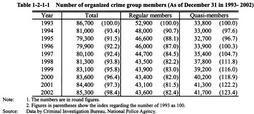| Previous Next Index Image Index Year Selection | |
|
|
1 Trends in organized crime groups Table 1-2-1-1 shows the trends in the number of regular members and quasi-members of organized crime groups both of them are (both of them are hereinafter referred to as "organized crime group members" in this section) as of December 31 of each year since 1993. The number of regular members has been almost the same since 1998 whereas the number of quasi-members has increased constantly since 1996.
Table 1-2-1-1 Number of organized crime group members (As of December 31 in 1993-2002) As of December 31, 2002, 24 organized crime groups were designated as designated organized crime groups under the Law to Prevent Unjust Acts by Organized Crime Group Members (hereinafter referred to as "Anti-Organized Crime Group Law" in this section). The number of regular members who belonged to the 3 major groups, the Fifth Yamaguchi-Gumi, the Inagawa-Kai, and the Sumiyoshi-Kai, was around 31,200 (up around 800 persons from the previous year), accounting for 71.6% of the total number of regular member of organized crime groups. Under the Anti-Organized Crime Group Law, 2,599 stop orders and 141 recurrence preventive orders were issued in 2002, increasing by 361 and by 45 from the previous year respectively (Source: Data by Criminal Investigation Bureau, National Police Agency).Fig. 1-2-1-2 shows the trends in the number of incidents of rivalries between organized crime groups that occurred over the last 10 years and the firearms use rate (the rate of firearm use to the number of incidents of rivalries between organized crime groups). In 2002, the number of incidents of rivalries between organized crime groups decreased by 53 from the previous year. Fig. 1-2-1-2 Trends in the number of incidents of rivalries between organized crime groups (1993-2002) |

